THE American WESTERN
By Jeffrey-Baptiste Tarlofsky
By Jeffrey-Baptiste Tarlofsky
Lesson 24 consists of 6 video lectures and transcripts of those lectures, and 5 film excerpts. Start with the lecture, Part 1 and continue down the page in sequence until you reach the end of the lesson.
レッスン24は、6本のビデオレクチャー(レクチャーのテキストがビデオレクチャーの下に記載されています)と5本の動画で構成されています。
このレッスンは、最初のLecture Part 1から順番に動画を見たりテキストを読んでください。
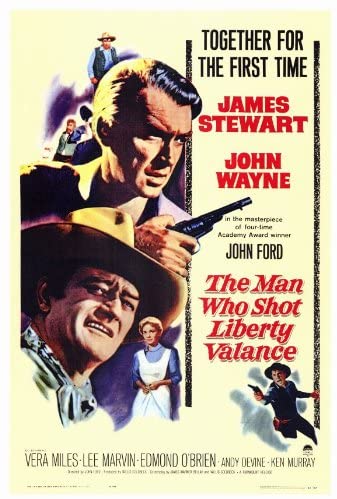
Directed by: John Ford
Produced by: Willis Goldbeck
Screenplay by: James Warner Bellah and Willis Goldbeck
Based on: a 1953 short story by Dorothy M. Johnson
Starring: John Wayne, James Steward, Lee Marvin, Vera Miles
Music by: Cyril J. Mockridge
Cinematograph: William H. Clothier
Running time: 123 minutes
Budget: $3.2 million
Box office: $8 million
Part 1 – John Ford made many kinds of movies in addition to Westerns and all four of his Academy Awards for Best Director were for non-westerns. But John Ford once famously introduced himself to a room full of his fellow film directors by saying “My name’s John Ford. I make Westerns”. Everyone laughed because Ford did not need to introduce himself or say what he did. He was the most famous person in the room and, of course, everyone knew he made Westerns! He was the undisputed master of the genre making more great Westerns than anyone else. Two of Ford’s films stand as “bookends” to the classic period of the American Western: Stagecoach, which begins this period, and The Man Who Shot Liberty Valance, which signals the end of the period. In other words, the period of the classic American Western film begins and ends with John Ford. He begins with a great film and I believe he also ends with a great film, (although not all critics and historians agree with me). Moreover, the films are interestingly connected. For example, four actors appear in both films: John Wayne, Andy Devine, John Carradine and the bartender (uncredited). In itself, this is hardly unusual because Ford had a stock company of actors he used repeatedly in many of his films. However, each character in The Man Who Shot Liberty Valance echoes the character the actor played in Stagecoach.
Ringo was a rancher who was also good with firearms and so is Tom Doniphon. In both films, these young men are in love with young women with a misfortune of some sort; Dallas has been forced by circumstances to become a prostitute and Hallie, also because of circumstances, is illiterate. Yet, the contrast between Ringo and Tom could not be more stark. Ringo and Dallas are together at the end of the film, but Tom loses Hallie. I will have much more to say about this later.
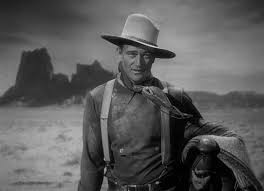
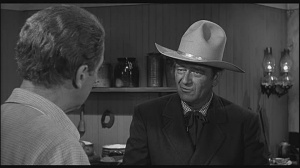
Andy Devine plays Buck and Marshal Appleyard. Both men are extremely likable characters and are used for comic relief in the films. We hear Buck talk about only getting “beans, beans, beans” when he is at home with his wife and obviously much of the humor associated with Marshall Appleyard relates to his constant mooching of food from Hallie’s parents’ restaurant. But isn’t it an interesting coincidence that both Buck and Appleyard are married to Mexican women and have large families? I will also talk more about this later.
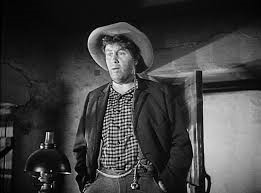
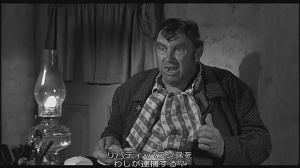
The third actor to appear in both films is John Carradine, who played Hatfield and Cassius Starbuckle. In both films, he appears as a well-dressed, courtly, but arrogant figure who claims to be motivated by higher principles: offering protection to a lady and defending the principle of legal due process, respectively. Yet, again, as with Ringo and Tom, there is a twist. Hatfield is sincere about protecting Lucy, but Starbuckle is only twisting the idea of the law to serve his own ends and that of the big cattle ranchers.
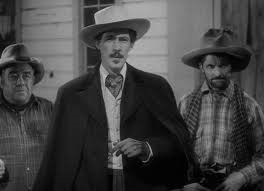
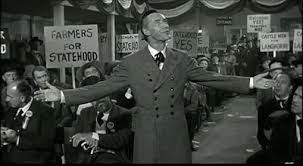
Even the nameless actor playing a bartender in both films has a slightly more dubious role to play in The Man Who Shot Liberty Valance when he tries to tell Tom that Pompey isn’t allowed in his saloon. Again, I will have more to say about this later.
John Ford seems to be using the The Man Who Shot Liberty Valance to reflect back on Stagecoach, the film he made twenty-three years earlier. In fact, The Man Who Shot Liberty Valance, is entirely about events that happened long ago. Of course, this is ultimately what all Western films are about, reflections on the past. But in The Man Who Shot Liberty Valance, that reflection on the past takes place within the film itself. The film is about remembering the past.
Now let’s have another look at the opening scene of the film and talk about how we go about dating the time it is set.
Part 2 – Through careful deduction, I have figured out that the year Senator Stoddard and his wife return to Shinbone for Tom’s funeral must be between 1905 and 1910. Let me explain how I figured this out. As he waits for the train, we see a substantial brick building behind former marshal Appleyard. This tells us that the town of Shinbone has grown considerably. But more important, after the Senator’s arrival we see the young reporter use the telephone. Later, as Appleyard drives Hallie down the street we do not see any automobiles on the streets. Since telephones first appeared in 1905 and automobiles in 1910, I judge the film to be set between the emergence of these two culturally transformative technologies.
We can also figure out even more exactly when Ransom Stoddard first arrived in Shinbone many years before. The events Senator Stoddard tells us about in his story are fictional except for the fight for statehood in the Colorado territory where the film is set. Colorado achieved statehood in 1876 so the events in the film would have happened in that year or perhaps 1875 at earliest. 1876 is significant for a number of reasons. It is the 100th anniversary of the Declaration of Independence, but it is also the year in which the Indians won their greatest battle against the white invaders at The Battle of the Little Big Horn. It was also a presidential election year. So we now know that Senator Stoddard is talking about events that happened about thirty years before. As he begins to tell his story he wistfully remembers that he arrived in Shinbone by stagecoach. This is the most obvious reference to the film Stagecoach. Senator Stoddard looks at the ruined old stagecoach and says “This might be the same one” (and indeed, it just might just be the same prop stagecoach Ford had used in the earlier film). So, John Ford is not just looking back at the Old West in this film, he is also looking back at old Hollywood. In 1939, John Ford was one of the most important directors in Hollywood and he had not yet reached the peak of his long career, but by 1962 Ford was, like the classic Western itself, reaching the end of his time in Hollywood. Ford would only direct one more important film after The Man Who Shot Liberty Valance. In many ways the film is his “swan song”*
*The swan song (ancient Greek: κύκνειον ᾆσμα; Latin: carmen cygni) is a metaphorical phrase for a final gesture, effort, or performance given just before death or retirement.
Part 3 – The “ladies” abuse their power over law enforcement in the town in order to inflict their social prejudices on less powerful people like Dallas and Doc.
What we see in The Man Who Shot Liberty Valance is a lady, of about the same age and class status as “The Ladies of The Law and Order League” in Stagecoach, who is completely helpless in the face of the outlaws.
To put it simply, Stagecoach showed us the negative side effects of law and order (it can be abused by those in power), but The Man Who Shot Liberty Valance shows us what the consequences of having no law and order at all are: robbery, assault, and attempted murder.
Both films begin with an innocent character as victim; Dallas is the victim of social prejudice, and Ransom is a victim of lawlessness. Ransom is confronted by the reality of “Western law”, which is actually lawlessness or the law of the jungle. Perhaps the most terrifying moment in this scene is when Liberty Valance takes off his handkerchief to reveal his face because it means he does not care if Ransom sees his face because he is not going to let Ransom live to be a witness against him.
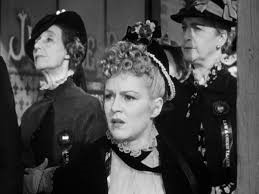
Dallas persecuted by the Ladies of the Law and Order League
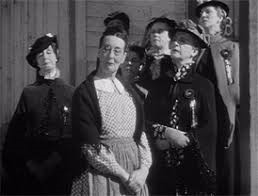
The “ladies” abuse their power over law enforcement in the town in order to inflice their social prejudices on less powerful peole like Dallas and Doc.
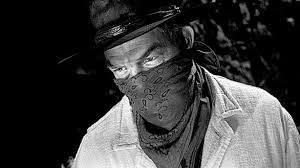
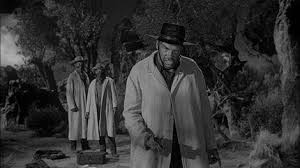
Valance then beats Ransom until his men pull him off. Apparently, they are used to Liberty losing control of himself this way since they don’t seem very surprised by what he does.
Liberty Valance rivals Jack Wilson from Shane as the most loathsome villain in the classic American Western film. Unlike the cool, smiling, sadistic Wilson, Valance is given to out of control rages like the one we have just witnessed. It was a break out performance for the thirty-eight-year-old former marine, Lee Marvin, who plays Valance as a very different kind of psychopath from Jack Palance’s Wilson. The two men had acted together as members of a criminal gang in the film I Died a Thousand Times where Palance was the cool-headed bad guy and Marvin the hot-headed one.
When it was announced that John Wayne and James Stewart would co-star in a John Ford Western there was speculation about whether one or the other would dominate on screen. In fact, the biggest challenge either of them had was keeping up with the explosive Lee Marvin who almost stole the lead from both of them. The movie was, after all named after his character.
Part 4 – After Ransom is rescued Tom tells him that what he experienced is just how things are in the West and that if he wants to protect himself he will need a gun because his law books are meaningless in the West. But Ransom will not accept this and angrily points out that Tom is saying exactly what Liberty Valance said! In fact, Tom accepts the “law of the West” just as much as Liberty Valance does because, as he points out, “Liberty Valance is the toughest man in the territory…next to me!” In other words, in this world governed by the law of the jungle, Tom is the lion in that jungle while Liberty Valance is perhaps a particularly nasty hyena. Ransom is little better than a sheep in this world.
But Ransom is outraged because he is not only a man from the civilized East, he is also a lawyer (a “lawman” and “an officer of the court”). He is angry and disgusted by what he has found in the West, but he has no intention of leaving. Ransom may not carry a gun, but he is actually tough in his own way, if only because he is so stubborn. As we watch the next excerpt you will see that both Tom and Ransom are tough in their own way.
Part 5 – Tom Doniphon is one of John Wayne’s larger than life characters. When he says he’s tougher than Liberty Valance we believe him and the confrontation in the restaurant certainly proves it. As terrifying as Liberty Valance is…Tom is simply not even the least bit frightened of him. That is how it is with lions and hyenas.
I said before that in the west survival depended on being able to judge a man…sometimes just the way he stands. When Shane stood behind Joe Starrett the first time, he faced the Rykers, he looked completely relaxed…and that is why Shane was so scary. If one man facing six men is that relaxed it means he is more dangerous than all six of those men together. When Tom Doniphon confronts Liberty Valance over the steak, we can see from their body language that both Tom and Liberty know Tom is faster…and Liberty also knows Tom will not hesitate to kill him. The confrontation here is every bit as serious as that which took place between Shane and Wilson at the end of Shane. When Shane said he heard that Wilson was a “low down Yankee liar” he was giving Wilson no choice but to fight or be dishonored. However, Wilson wanted to fight because he thought he could win.
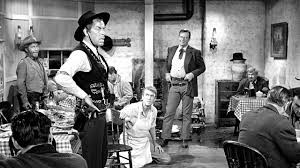
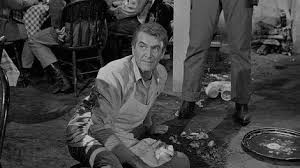
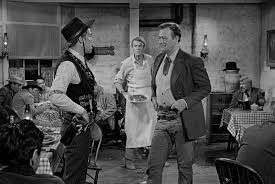
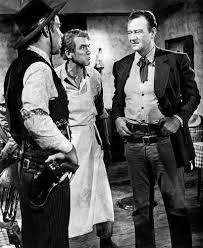
On the other hand, Liberty Valance knows he cannot beat Tom Doniphon, but Tom is giving him the same choice; “fight me or face dishonor”. Valance has a choice of picking up the steak (losing his honor in front of half the town) or shooting it out with Tom. Tom won’t draw first, but if Liberty tries to draw, Tom will surely kill him. One way or the other, Tom will put an end to Liberty by either dishonoring him or killing him. We want Liberty to try to draw on Tom because we are also certain Tom is faster. But just as the tension becomes unbearable…Ransom rescues Liberty!
Ransom doesn’t do this to save Liberty, however. Ransom is once again outraged because he does not believe violence is the answer to anything. But there is another reason he stops the fight. Ransom has already been humiliated by Liberty Valance, but it is almost as humiliating to be protected by Tom as it is to be bullied by Liberty. “Nobody fights my battles!”, he shouts at Tom.
Now we come to a crucial moment in the film. In the next excerpt let’s go back to an earlier scene for just a moment.
Part 6 – Ransom doesn’t realize it yet, but this is his secret weapon. Ransom Stoddard has come to a place where there is no law and order, where Tom tells him his books don’t mean anything. But why don’t the law books mean anything? It is because most people in this town (and in the West at this time) were illiterate, unable to read and write. When we studied The Left Handed Gun we talked about the fact that Billy the Kid is illiterate, but John Tunstall offers to teach him how to read. What Tunstall was offering Billy was a chance to better himself. Perhaps if Tunstall had not been murdered he might have taught Billy to read and write and Billy’s life might have been very different. The Left Handed-Gun was a social commentary on the problem of juvenile delinquency in the United States in the 1950s and it was making the point that when children stay in school they are more likely to avoid trouble and become juvenile delinquents. Children who fail to learn to read are far more likely to drop out of school. Children who learn to love reading are far more successful in school.
Ransom offers to teach Hallie how to read because he knows she feels ashamed of her illiteracy. But he has also found the key to how he is going to begin to transform the town of Shinbone. The people of the town do not need a lawyer because there is no law and order in their town. But one large reason for the lack of law and order is that so few people can read and write. Laws are written, after all. How can people respect the law when they cannot even read a sign that says “Do not spit here”.
Moreover, we are talking about a time long before the internet, television, radio or even the movies. For most people, listening to public speeches or reading newspapers was the only way to learn about the issues of the day. Certainly, one of the main issues of the day in the town of Shinbone was the issue of lawlessness. The newspaper editor, Mr. Peabody, becomes a very important character in the story. He offers to help Ransom by letting him practice law from the newspaper office and he hires Ransom as a reporter for the newspaper. He also allows Ransom to use the offices of the newspaper as a school.
But by learning about Hallie’s illiteracy Ransom has come to understand something very fundamental. Before the town can use a lawyer, it needs a school teacher to teach them how to read and write. So, Ransom Stoddard, attorney at law, becomes Shinbone’s first school teacher.